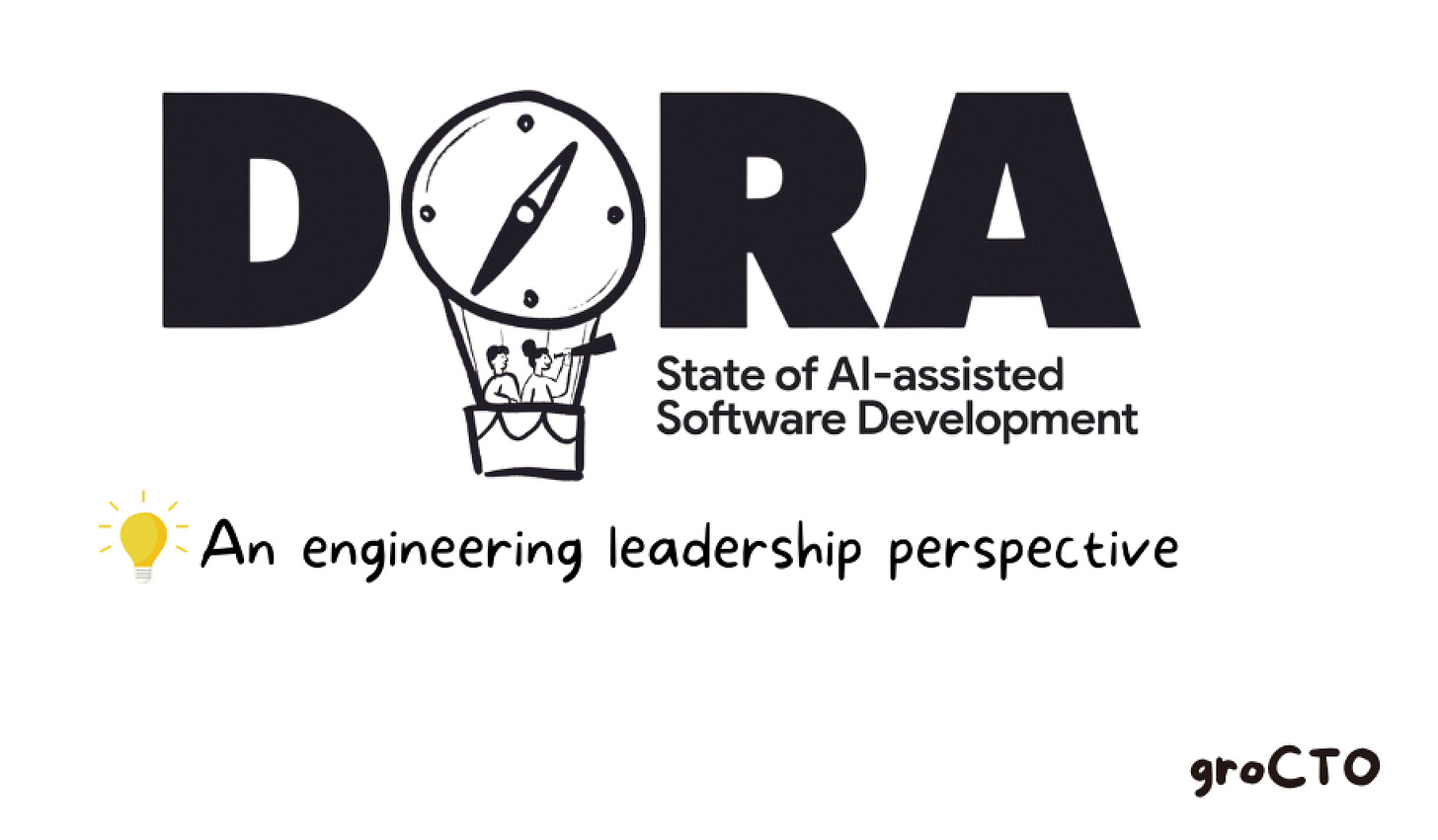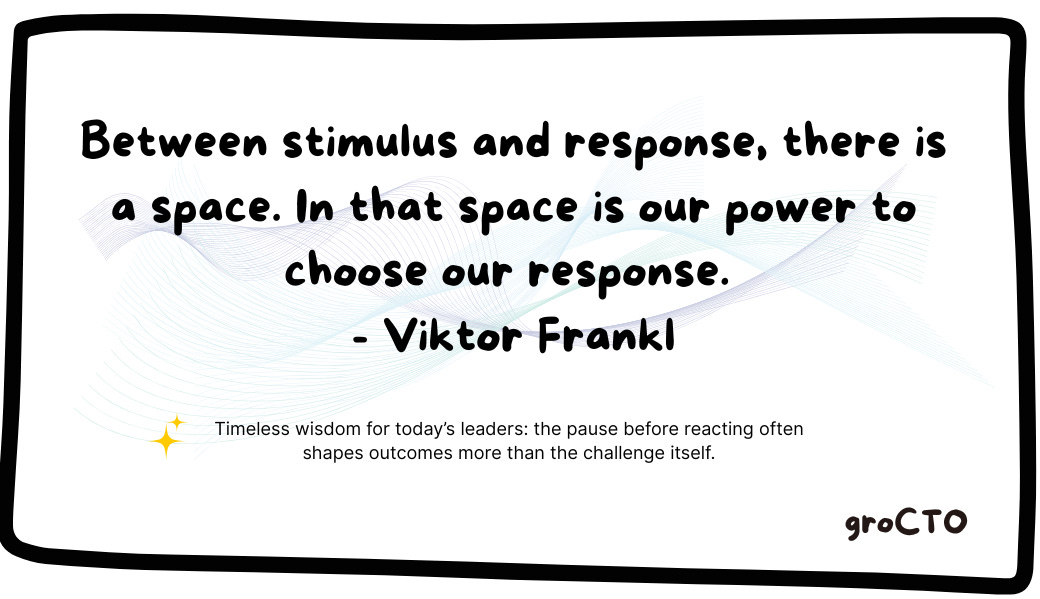Thoughtworks leaders review 2025 DORA Report; Managing Stress in your Team; AI and Copilot
Issue #67 Bytes
🌱 Dive into Learning-Rich Sundays with groCTO ⤵️
Article of the Week ⭐
“The modern engineer’s value is in prompt engineering, solution architecture and validating AI-generated outputs, not just in writing code. Without the right structure and processes, AI can turn speed into chaos.“
The 2025 DORA Report - An engineering leadership perspective
AI is rewriting the rules of software delivery. Teams are shipping more code, faster. But the flip side is showing already in instability, fragile pipelines, and developer burnout when foundations aren’t ready. Not to mention
Chris Westerhold, Thoughtworks’ Global Director of Engineering Excellence puts his experience and translates it into an AI-adoption initiative using the latest DORA report:
⚡ What DORA Found
AI accelerates delivery by amplifying what’s already there: Great teams see an increase, lagging teams slow down.
more code ≠ more value: instability rises when systems lack testing, architecture, and solid pipelines.
Developer experience matters: AI tool fragmentation creates context switching, validation overhead, and burnout.
New forms of waste: time lost to AI latency, re-explaining context, tool hopping, and endless validation of AI-generated code.
🧭 Thoughtworks’ Playbook for Leaders
Run your org like an optimization engine
Pair engineering metrics with business outcomes.
Experiment, measure, scale. Don’t tack AI onto processes you do not measure.
Invest in platform engineering
Provide a “paved road” with guardrails and flexibility.
Build infra as a product, ready for AI-first workflows.
Prioritize developer experience
Remove friction before introducing automation
Shift from static docs to real-time, context-aware systems.
AI will expose and amplify signals of weak teams, siloed orgs and broken pipelines. The leaders who thrive will treat AI as part of a systemic engineering transformation initiative. If you’re still measuring success by how much faster code ships, you’re already behind.
Other highlights 👇
From Chaos to Calm
Mastering Stress Management for Your Team
Every team feels pressure but whether that pressure sharpens focus or destroys morale depends almost entirely on how you, as the manager, handle it. Gert Lõhmus makes the case that stress is unmanaged external pressure. Left unfiltered, it flows straight from execs, deadlines, and stakeholders into your team.
Your job as a manager isn’t to eliminate stress but rather to shield, contextualize, and translate it so your people can do their best work without burning out.
5 flavors of stress managers must buffer:
Workload stress → unrealistic deadlines and too much work.
Ambiguity stress → unclear priorities and shifting goals.
Conflict stress → competing stakeholder demands.
Emotional stress → the team absorbs your panic if you project it.
Accountability stress → fear of being blamed for things outside their control.
Early warning signs: drop in energy, more mistakes, increased irritability, or that familiar “just getting through the day” vibe. If you see silos forming, gossip rising, or quality slipping, you’ve already let too much chaos through the gates.
How to shield effectively (and visibly):
Filter before forwarding – frame requests and pass only what matters.
Negotiate scope/timelines – don’t dump exec pressure raw onto the team.
Reframe stress – “here’s the plan” beats “we can’t fail.”
Absorb conflict upward – fight the battles with stakeholders so your team doesn’t have to.
Protect boundaries – guard focus time and stop after-hours creep.
A shielded team performs better, collaborates more smoothly, and actually trusts leadership. A non-shielding manager? They’re just a stress relay.
The AI productivity myth is more harmful than you think
AI coding tools promise speed, but Himanshu Saxena warns they’re quietly creating a new kind of debt. Unlike technical debt, which is visible in the codebase copilot debt builds silently in three places: knowledge, consistency, and verification.
Knowledge debt → Engineers accept AI code they don’t fully understand, leaving “orphaned” logic no one can explain later.
Consistency debt → Copilot generates different naming conventions, logging styles, and structures across files—creating a patchwork codebase that slows onboarding and review.
Verification debt → More AI code = more PRs = reviewer overload. Senior engineers burn out validating subtle bugs hidden in massive diffs.
The data backs it up: GitClear found a 10x increase in code duplication since AI adoption. Stack Overflow survey reports 45% of developers now spend more time debugging AI code than writing it from scratch.
Stay Ahead of the Problems
You can’t measure copilot debt with lines of code or story points, those metrics are inflated by the very output that causes the problem.
Name it → Call out knowledge/consistency/verification debt explicitly in retros and post-mortems.
Measure it → Track code duplication, review queue times, and developer trust in AI output. Treat spikes as leading indicators.
Balance it → Keep PRs small (200–300 lines), rotate review load, and use AI tools as a first filter if necessary prior to humans focus on judgment, not boilerplate.
Copilots are reshaping the economics of software leadership. Trust, comprehension, and consistency are taking over as the new bottleneck after unlocking time and speed constraints.
Why AI’s Impact Still Feels Unclear
Every engineering team today has some footprint of AI, a few developers using Copilot, a pilot with Cursor, maybe a team experimenting with Claude. What’s less common is a clear picture of what all this change adds up to.
As Kshitij Mohan, Typo’s founder & CEO, often says, “Everyone’s experimenting with AI coding agents. But without measuring outcomes, it’s like vibe coding on production.”
AI is quietly reshaping how code travels through pipelines, influencing defect density, PR patterns, and review behaviour in ways teams rarely notice until they slow down. Those who measure these shifts early will understand not just how AI accelerates work, but where it adds friction, context-switching, or unseen drag.
Kshitij recently shared a LinkedIn post on building the right approach to measure AI’s impact on software engineering.
Find Yourself 🌻
That’s it for Today!
Whether you’re innovating on new projects, staying ahead of tech trends, or taking a strategic pause to recharge, may your day be as impactful and inspiring as your leadership.
See you next week(end), Ciao 👋
Credits 🙏
Curators - Diligently curated by our community members Denis & Varun
Featured Authors - Chris Westerhold (Thoughtworks), , Himanshu Saxena (LeadDev), Kshitij Mohan
Sponsors - This newsletter is sponsored by Typo AI - Engineering Intelligence Platform for the AI Era.
1) Subscribe — If you aren’t already, consider becoming a groCTO subscriber.
2) Share — Spread the word amongst fellow Engineering Leaders and CTOs! Your referral empowers & builds our groCTO community.






Thank you for the mention!